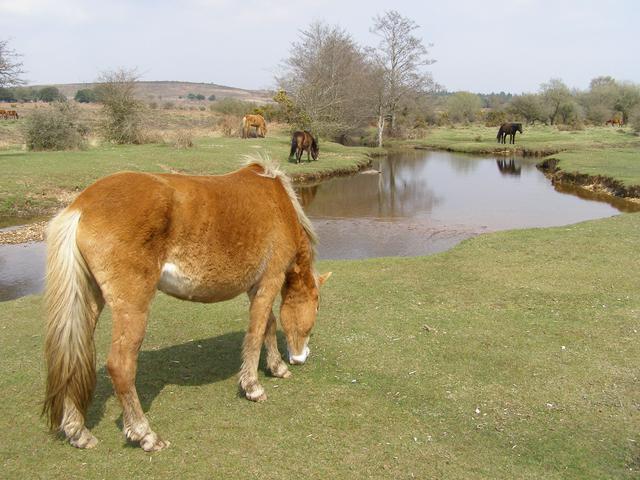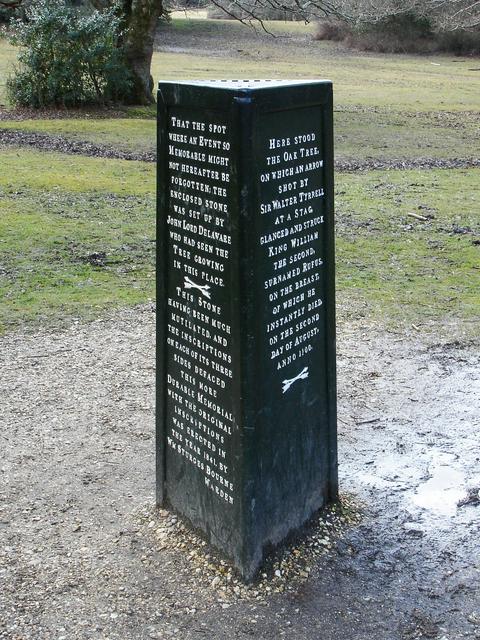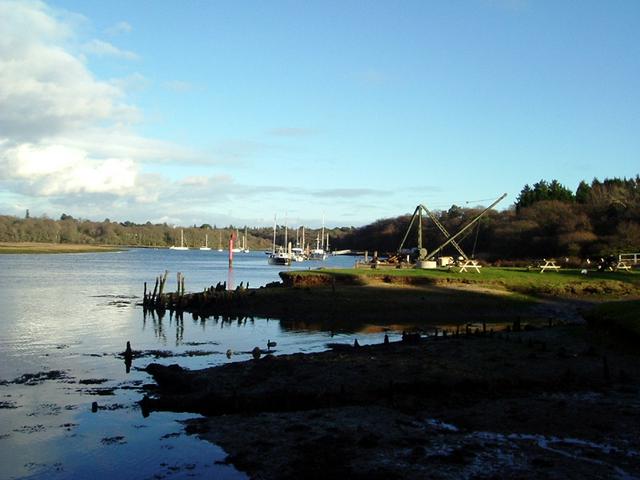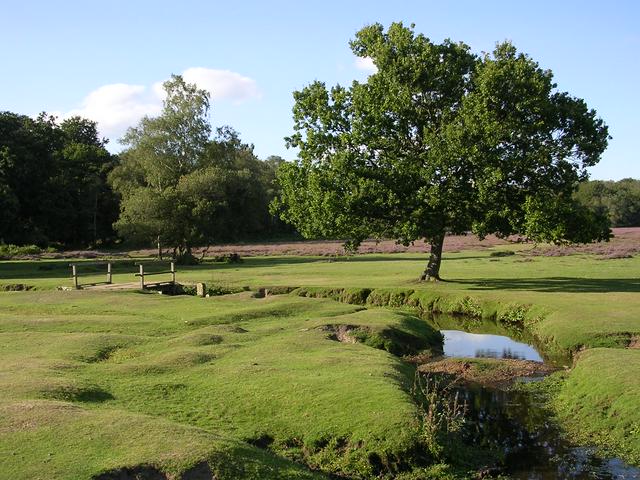
The New Forest is a major tourist area and a national park in Hampshire. It is immensely popular with British campers, as it is one of two national parks in the densely populated South East of England.
The name 'New Forest' is somewhat misleading, as it is neither new (it was established in 1079), nor a forest in the current sense of the word. It is rather it is a patchwork of areas of open heath and gorselands, intermixed with forested 'enclosures'.
It was established by William I as a royal deer-hunting reserve, and it is this which was the original meaning of the word "forest". He introduced the Forest Law, a strict and savage legal code which forbade the local peasantry from doing anything that would interfere with his pursuit of deer, forbidding them from enclosing land for agriculture, for example, erecting fences or barriers, or even owning a bow. In slight recompense, they were given the right to graze their ponies, cattle and pigs in common (i.e. running free) across the forest. The result of this regime, together with the Royal Navy's need for oak trees during the Napoleonic wars (which led to the development of the forested enclosures) has given us a unique, if very much man made, landscape.
The New Forest has an area of about, and can become very busy on a spring or summer weekend. Road traffic can be a problem on the narrow unfenced roads, which all have a 40 mph speed limit to safeguard the animals. Off the paved roads, however, there are miles of unpaved forest road ideal for walking and cycling.
The New Forest was designated a national park in 2005.
The New Forest is very sparsely populated, but there are several towns and large villages that have good pubs and restaurants to dine at, attractions to see and supermarkets to stock up at.
- Lyndhurst. - main town of the New Forest
- Beaulieu.
- Bransgore.
- Burley.
- Brockenhurst.
- Fordingbridge.
- Lymington.
- Ringwood.
Lyndhurst. - main town of the New Forest
Beaulieu.
Bransgore.
Burley.
Brockenhurst.
Fordingbridge.
Lymington.
Ringwood.
The New Forest has several important or unusual habitats including both wet and dry heathland, alder carr (think of a semi-flooded woodland) and deciduous forest. Heaths and carrs are typical of southern England, but rare on the international scale. Semi-wild ponies, cattle and pigs still roam across the forest, sharing it with several species of wild deer and leading to a very special flora and fauna driven by their grazing. The ponies especially have become a symbol of the forest, and the New Forest Pony is a recognised breed.
There are several rare insect species including the southern damselfly and the mole cricket. Indeed, the rarest animal of the forest is an insect, Cicadetta montana, which is Europe's most northerly cicada. The last confirmed sighting was in 2000, and it is feared nationally extinct, but local entomologists believe it may still cling on in isolated pockets. If you want to help find Britain's last cicadas, there is a tracking app available to download which recognises the insect's shrill call even where human ears struggle.
As with the rest of the UK, the weather in the New Forest is notoriously unpredictable. In the winter, it will often be rainy or overcast, with frost and occasional light snow. In the summer, temperatures will range from 12 to 28°C making staying in the Forestry Commission campsites only very occasionally a bit hot as there are no swimming pools. Spring and autumn can be anywhere in between. The best time to camp is early summer; however, visits are possible all year round, providing you don't mind getting a bit wet!
Entrance to the park is free.
Long-term conservation and preservation are goals of the Forestry Commission. Following their simple rules will help to maintain this delicate area. In the New Forest the well-being of the animals and the needs of the countryside come first. The Codes below are provided by The Forestry Commission.
- If you cannot control your dog, keep it on a lead.
- A dog out of sight may be out of control. It must not be allowed to disturb or chase livestock or wildlife.
- Keep to the existing tracks on the forest when birds nest on the ground (1 March - 31 July). At this time, keep your dog close by or you may be asked by a forest ranger or keeper to put it on a lead.
- Prevent your dog fouling on footpaths and around car parks. If it does foul, remove the waste.
- Groups of dogs can be intimidating to other forest users and wildlife. Keep them under control.
- Be considerate to other forest users, particularly children at play and picnickers.
- Keep well away from any work taking place in the forest.
- Prevent excessive barking from your dog.
- Keep to the tracks when the ground is soft or muddy. When there is no alternative, keep to a slow pace.
- Take an alternative route to avoid soft slopes. Riding straight up and down causes erosion.
- Avoid widening existing tracks, or creating new ones. Keep off re-seeded areas and recently reinstated rides.
- Vary your route on the forest to spread the wear and tear.
- Keep to the tracks when birds are nesting on the ground (1 March - 31 July).
- Slow down and call out a warning when approaching other forest users. Be courteous and friendly.
- Do not build jumps or create lunging areas on the forest.
- Keep well away from any work taking place in the forest.
- Never ride more than two abreast. Limit groups to a maximum of eight horses on the road.
- Be safe and plan ahead - follow any signs and aim to be out of the forest by dusk.
- Close all gates behind you unless they have been fastened open.
- Do not pick or remove plants or flowers.
- Do not feed or disturb the common stock - ponies, cattle and donkeys. Give them space and do not touch them.
- Take your litter home and do not light fires.
- Keep to the existing tracks on the forest when birds nest on the ground (1 March - 31 July). At this time, keep your dog close by or you may be asked by a forest ranger or keeper to put it on a lead.
- Keep below the forest speed limit (40 mph) and slow down when approaching walkers, riders or livestock.
- Do not park on verges or in gateways. Use one of the many car parks.
- Keep well away from any forestry work and obey the warning signs.
- Keep to the way-marked gravel tracks when cycling in the forest.
- Slow down and call out a warning when approaching other forest users. Be courteous and friendly.
- Take extra care when nearing horse riders. When in a group, all cyclists should pass the horse on the same side.
- Do not startle ponies, cattle or wildlife. Go slowly and give them space.
- Avoid causing obstructions - do not ride more than two abreast. Always ride in single file on narrow roads.
- Keep well away from any work going on in the forest.
- Do not pass any vehicle loading timber until you have been told it is safe to do so.
- Use the map, and plan to be out of the forest by dusk.
The main thing to see in the New Forest is the forest itself. Throughout the forest there are areas of heathland, forested enclosures, upland streams and the free roaming New Forest Ponies.
However there are some more specific attractions, as described in the following sections.
The Northern Forest is that part of the forest north of the very busy A31 road which bisects the forest and forms something of a barrier for both visitors and the local flora and fauna. Compared to the Southern Forest, the Northern Forest is higher and has more open heathland and less woodland. With a smaller population and fewer roads, this part of the forest tends to be less busy.
Other than the forest, there are a few other attractions.

- Rufus Stone, SO43 7HN (in an attractive glade just north of the A31 towards the eastern boundary of the forest; it is clearly signposted from the dual-carriageway. Open daylight hours. The stone marks the spot where popular myth has it that King William II, often called William Rufus and son of William the Conqueror, was killed by an arrow shot by Walter Tyrell, while hunting on 2 August 1100. Whilst it was called an accident, the fact that William's body was left to rot where he fell by his hunting companions, and the reaction of his brother Henry in immediately riding to Winchester to claim the treasury and the crown does make one wonder. The actual location of William's death was probably a fair bit to the south but no one really knows for sure. Free.
- Breamore House, SP6 2DF (Breamore village is 3miles north of Fordingbridge. Follow the brown signs from the A338 Salisbury Road., +44 1725 512 858. Apr and Oct: Tu Su noon-5:30PM; May-Sept: Tu-Th Su noon-5:30PM; and open bank holidays throughout the year. An Elizabethan (late 16th century) manor house with very fine furniture and paintings. Also onsite is an agricultural museum with a comprehensive collection of steam-powered farm machinery. The museum and the ground floor of the house are fully accessible to wheelchair users. Adults £9.50, seniors £8, children (5-15 years) £6, children under 5 free.
Rufus Stone, SO43 7HN (in an attractive glade just north of the A31 towards the eastern boundary of the forest; it is clearly signposted from the dual-carriageway. Open daylight hours. The stone marks the spot where popular myth has it that King William II, often called William Rufus and son of William the Conqueror, was killed by an arrow shot by Walter Tyrell, while hunting on 2 August 1100. Whilst it was called an accident, the fact that William's body was left to rot where he fell by his hunting companions, and the reaction of his brother Henry in immediately riding to Winchester to claim the treasury and the crown does make one wonder. The actual location of William's death was probably a fair bit to the south but no one really knows for sure. Free.
Breamore House, SP6 2DF (Breamore village is 3miles north of Fordingbridge. Follow the brown signs from the A338 Salisbury Road., +44 1725 512 858. Apr and Oct: Tu Su noon-5:30PM; May-Sept: Tu-Th Su noon-5:30PM; and open bank holidays throughout the year. An Elizabethan (late 16th century) manor house with very fine furniture and paintings. Also onsite is an agricultural museum with a comprehensive collection of steam-powered farm machinery. The museum and the ground floor of the house are fully accessible to wheelchair users. Adults £9.50, seniors £8, children (5-15 years) £6, children under 5 free.
The Southern Forest is that part of the forest south of the A31. This is lower lying, with a greater proportion of woodland although heathland still occupies a significant proportion of the area. The Southern Forest is more inhabited, containing all the major forest villages, and tends to see more visitors.
- Exbury Gardens, +44 2380 891203. Mar-Oct: daily 10AM-5:30PM. Exbury Gardens is a spectacular 200-acre woodland garden, world famous for the Rothschild collection of rhododendrons, azaleas & camellias. Best seen in late spring (up until the beginning of June), when the rhododendrons and azaleas are at their best. £7.50 adult, £3.50-5.50 senior; £1-1.50 child (higher price applies during rhododendron and azalea flowering season).

- Buckler's Hard, +44 1590 614645. Easter-Sep: daily 10:30AM-5PM; Oct-Easter: daily 11AM-4PM. Buckler's Hard is a very pretty 18th century village with a single wide street running down to the Beaulieu River. During the Napoleonic Wars, with Britains urgent need for ships and the New Forest's abundant supply of Oak, Bucklers Hard became a major shipbuilding centre. Many warships, including Nelson's Agamemnon, were built on the slips at the foot of the village street. In some of the village buildings is The Maritime Museum with displays on the villages history. Admission to the village street and riverside is free; museum admission is £5.90 adult, £4.75 senior, and £3.75 child.

- Beaulieu Village is a very attractive village on the River Beaulieu (bigger than the picture shows!) with a handful of pretty good attractions - an Abbey, a Palace and a Motor Museum.
- New Forest Wildlife Park. Daily 10AM-5:30PM in spring/summer; daily 10AM-dusk in autumn/winter. They've gotta lotta otter. Along with a fine owl collection, wolves, deer, quite a lot of butterflies and a few other odds and ends including a rare albino wallaby. Admission is £9.95 adults, £6.95 children, and £8.95 seniors.
Exbury Gardens, +44 2380 891203. Mar-Oct: daily 10AM-5:30PM. Exbury Gardens is a spectacular 200-acre woodland garden, world famous for the Rothschild collection of rhododendrons, azaleas & camellias. Best seen in late spring (up until the beginning of June), when the rhododendrons and azaleas are at their best. £7.50 adult, £3.50-5.50 senior; £1-1.50 child (higher price applies during rhododendron and azalea flowering season).
Buckler's Hard, +44 1590 614645. Easter-Sep: daily 10:30AM-5PM; Oct-Easter: daily 11AM-4PM. Buckler's Hard is a very pretty 18th century village with a single wide street running down to the Beaulieu River. During the Napoleonic Wars, with Britains urgent need for ships and the New Forest's abundant supply of Oak, Bucklers Hard became a major shipbuilding centre. Many warships, including Nelson's Agamemnon, were built on the slips at the foot of the village street. In some of the village buildings is The Maritime Museum with displays on the villages history. Admission to the village street and riverside is free; museum admission is £5.90 adult, £4.75 senior, and £3.75 child.
[[Beaulieu|Beaulieu Village]] is a very attractive village on the River Beaulieu (bigger than the picture shows!) with a handful of pretty good attractions - an Abbey, a Palace and a Motor Museum.
New Forest Wildlife Park. Daily 10AM-5:30PM in spring/summer; daily 10AM-dusk in autumn/winter. They've gotta lotta otter. Along with a fine owl collection, wolves, deer, quite a lot of butterflies and a few other odds and ends including a rare albino wallaby. Admission is £9.95 adults, £6.95 children, and £8.95 seniors.
- A good way for a first-time visitor to see the new forest by bus is the new New Forest Tour, an open top bus route which runs on a one-way loop through the forest serving Lyndhurst, Beaulieu, Lymington, Brockenhurst and many intermediate rural locations. Buses run every 60 minutes during the summer, and you can get off at any point and catch the next bus after you have looked around.
- Visit the adjoining town and small port of Lymington, and maybe even catch the ferry across the Solent from there to the very pretty (and even smaller) port of Yarmouth on the Isle of Wight.
- Paulton's Park. Fully open Apr–Oct, generally 10AM–5:30PM. Christmas at Paultons: weekends and certain other days in Nov–Dec: 10:00–16:30. Closed 24 December–31 March. a popular family theme park with over 40 rides, as well as a small zoo, gardens and 'park within a park' Peppa Pig World Adults and children taller than 1 m: £31.75 / £27.25 advance; children under 1 m: free.
- Furzey Gardens. a beautiful country garden with adventure playgrounds, tree houses and mini fairy houses for kids to discover. There's also a museum and tea rooms. Furzey Gardens won a gold medal at the 2011 Chelsea Flower Show.
A good way for a first-time visitor to see the new forest by bus is the new New Forest Tour, an open top bus route which runs on a one-way loop through the forest serving [[Lyndhurst]], [[Beaulieu]], [[Lymington]], [[Brockenhurst]] and many intermediate rural locations. Buses run every 60 minutes during the summer, and you can get off at any point and catch the next bus after you have looked around.
Visit the adjoining town and small port of [[Lymington]], and maybe even catch the ferry across the Solent from there to the very pretty (and even smaller) port of [[Yarmouth (England)|Yarmouth]] on the [[Isle of Wight]].
Paulton's Park. Fully open Apr–Oct, generally 10AM–5:30PM. Christmas at Paultons: weekends and certain other days in Nov–Dec: 10:00–16:30. Closed 24 December–31 March. a popular family theme park with over 40 rides, as well as a small zoo, gardens and 'park within a park' Peppa Pig World Adults and children taller than 1 m: £31.75 / £27.25 advance; children under 1 m: free.
Furzey Gardens. a beautiful country garden with adventure playgrounds, tree houses and mini fairy houses for kids to discover. There's also a museum and tea rooms. Furzey Gardens won a gold medal at the 2011 Chelsea Flower Show.
There is a very good bike store in Brockenhurst, which will be able to supply most parts to allow you to make any repairs. The also hire bikes out.
There are camp stores in Lyndhurst.
- Breamore House Tea Barn is a cafe in the heart of the Hampshire country side. It is situated in the grounds of Breamore House, a manor house dating back to the 16th century.
Breamore House Tea Barn is a cafe in the heart of the Hampshire country side. It is situated in the grounds of Breamore House, a manor house dating back to the 16th century.
The ponies here are feral and although pretty, are best left alone. Do not feed them as this encourages them to pester people for food and never get between a mother and her foal as they will kick out. The same applies to the deer who inhabit the park, with extra caution to be taken during the autumn rutting season, when the testosterone-fuelled males grow antlers and compete with one other for the right to breed.
- Isle of Wight
- There are nice beaches in nearby Christchurch
- Fleet Air Arm museum in Yeovilton
- Bovington Tank Museum is approximately 45 min drive away
[[Isle of Wight]]
There are nice beaches in nearby [[Christchurch (England)|Christchurch]]
Fleet Air Arm museum in [[Yeovilton]]
